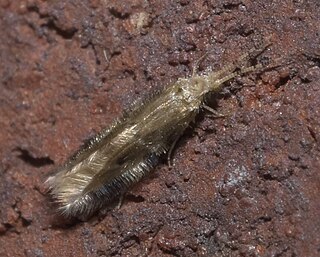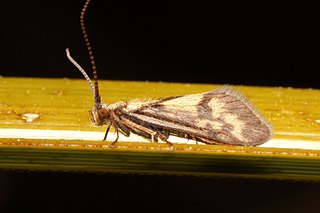
The caddisflies, or order Trichoptera, are a group of insects with aquatic larvae and terrestrial adults. There are approximately 14,500 described species, most of which can be divided into the suborders Integripalpia and Annulipalpia on the basis of the adult mouthparts. Integripalpian larvae construct a portable casing to protect themselves as they move around looking for food, while annulipalpian larvae make themselves a fixed retreat in which they remain, waiting for food to come to them. The affinities of the small third suborder Spicipalpia are unclear, and molecular analysis suggests it may not be monophyletic. Also called sedge-flies or rail-flies, the adults are small moth-like insects with two pairs of hairy membranous wings. They are closely related to the Lepidoptera which have scales on their wings; the two orders together form the superorder Amphiesmenoptera.

The Annulipalpia, also known as the "fixed-retreat makers", are a suborder of Trichoptera, the caddisflies. The name of the suborder refers to the flexible terminal segment of the adult maxillary palps, which often has many tiny rings.
The Spicipalpia are a suborder of Trichoptera, the caddisflies. The four families included in this suborder all have the character of pointed maxillary palps in the adults. The larvae of the different families have varying lifestyles, from free-living to case-making, but all construct cases in their final larval instar for pupation or at an earlier instar as a precocial pupation behavior. Although recognized under some phylogenies, molecular analysis has shown this group is likely not monophyletic.

The Integripalpia are a suborder of Trichoptera, the caddisflies. The name refers to the unringed nature of maxillary palp's terminal segment in the adults. Integripalpian larvae construct portable cases out of debris during the first larval instar, which are enlarged through subsequent instars. These cases are often very specific in construction at both the family and genus level.

Phryganeoidea is a giant caddisfly superfamily that may be paraphyletic with Limnephiloidea.

Amphiesmenoptera is an insect superorder, established by S. G. Kiriakoff, but often credited to Willi Hennig in his revision of insect taxonomy for two sister orders: Lepidoptera and Trichoptera (caddisflies). In 2017, a third fossil order was added to the group, the Tarachoptera.

Helicopsychidae are a family of Trichoptera. The name refers to the helix shaped larval cases and they should not be confused with Limnephilidae which sometimes inhabit the snail shells. Their shells range from 6–8 millimetres (0.24–0.31 in) and are crafted from mineral grains. Their typical habitat is in slow-flowing water in ditches. Helicopsychidae larvae have a comb-like anal hook. Helicopsychidae is divided into two extant genera, Rakiura and Helicopsyche, and two fossil genera Electrohelicopsyche and Palaeohelicopsyche. The family contains more than 270 species and are present on all major faunal regions.

The Hydroptilidae are a large family of caddisflies (Trichoptera) with a worldwide distribution. They are commonly known as microcaddisflies or purse-case caddisflies, in reference to two characteristic traits of this family: Hydroptilidae are much smaller than other caddisflies, rarely exceeding 5 mm (0.20 in) in length. Their larvae do not build a protective case until the final instar of their growth. At that time however, they build a typically Purse-shaped case, either portable or stuck to the substrate, in which the larva finishes growth and pupates.

The Hydropsychidae are a family-level taxon consisting of net-spinning caddisflies. Hydropsychids are common among much of the world's streams, and a few species occupy the shorelines of freshwater lakes. Larvae of the hydropsychids construct nets at the open ends of their dwellings which are responsible for their "net-spinning caddisfly" common name.

The Ecnomidae are a family of caddisflies comprising 9 genera with a total of 375 species.

The Psychomyiidae are a family of tube-making caddisflies. Members of this family are typically very similar to polycentropodids, most of them can be differentiated by the spur formula is 2-4-4, thyridial cell short, absence of the forewing fork I, and hindwing forks I and IV. Male genitalia has elongate preanal appendages, and reduced tergum IX. The larvae differ by the submental sclerites separated, foretrochantin broad, and the pupal mandible apex whip-like. Larvae construct long silken galleries.

Philopotamidae is a family of insects in the order Trichoptera, the caddisflies. They are known commonly as the finger-net caddisflies.
Kokiriidae is a family of insect in the order Trichoptera. It was discovered in 1964 and is found in Australia, Chile, New Caledonia, and New Zealand. It consists of fifteen species and six genera.

Lepidostomatidae is a family in the order Trichoptera. It is widely dispersed around the world. Larvae shapes vary. Larvae are normally found near bodies of water. It was first discovered by Georg Ulmer in 1903.

Uenoidae is a family of stonecase caddisflies in the order Trichoptera. There are about 7 genera and at least 80 described species in Uenoidae.

Chimarra is a genus of little black caddisflies in the family Philopotamidae. There are more than 630 described species in Chimarra.

Phryganeoidea, the giant caddisfly superfamily, may be paraphyletic with Limnephiloidea.
Anisocentropus krampus is a species of caddisfly in the family Calamoceratidae. It was described in 1994 by Austrian entomologist Hans Malicky and found in New Britain.

Conoesucidae is a family of caddisflies in the order Trichoptera. There are about 12 genera and more than 40 described species in Conoesucidae.

Hymenopterida is a superorder of holometabolous (metamorphosing) insects. As originally circumscribed, it included Hymenoptera and the orders in Panorpida. However, more recent studies find Hympenoptera as sister to the other members of Holometabola and the superorder is restricted to Hymenoptera.
















